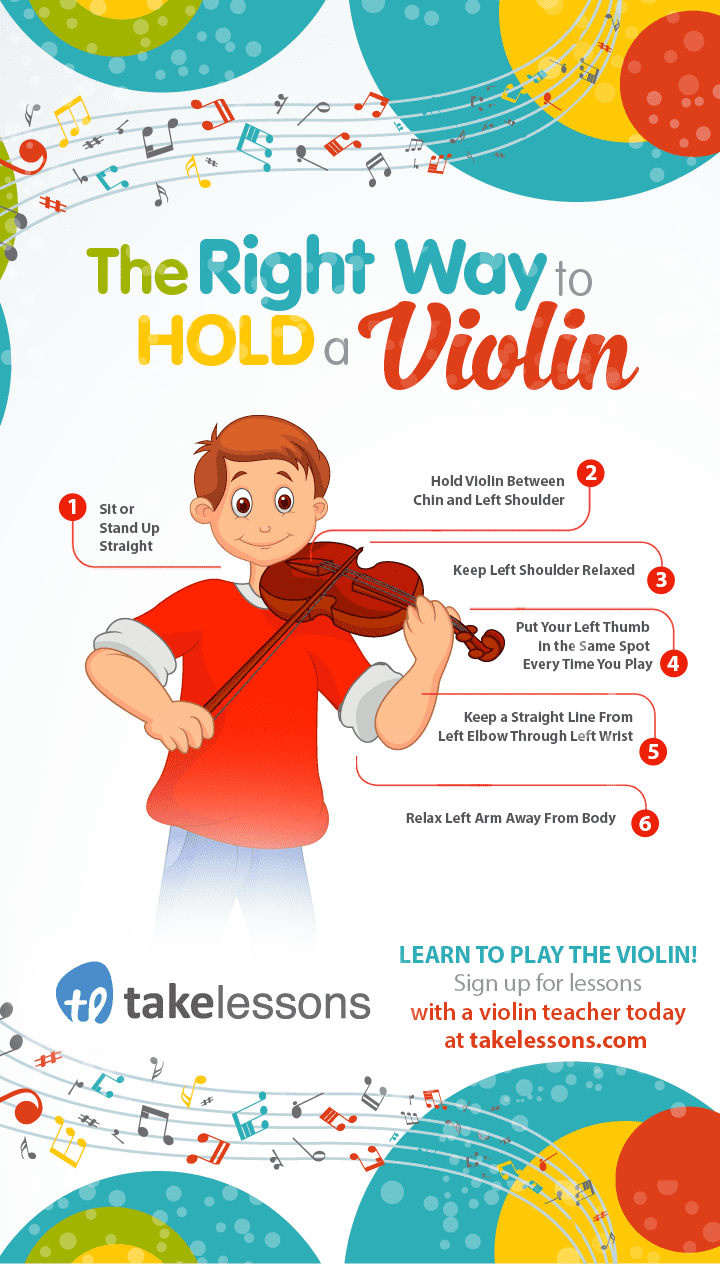How you hold your violin makes a huge difference in the way you sound. Below, violin teacher Julie P. shares some helpful tips on how to hold a violin properly…
As a beginner violin student, you know that posture is very important when playing the violin. Since there aren’t any keys to push, every sound is created by forming precise angles with the violin and bow. Below are some tips on how to hold a violin properly and how to find the best posture to support your playing.
1. Sit or Stand Up Straight
Why it’s important: Maintaining an upright playing posture is not only good for your body, it also helps create enough space between the violin and your body to allow for excellent bow and arm movements.
Slouching will make it more difficult to play and can even lead to long-term injuries.
2. Hold Violin Between Chin and Left Shoulder
Why it’s important: The left hand needs a lot of flexibility. Not only do the fingers need to be able to move quickly, when you get into more advanced music, the left hand will have to shift up the fingerboard to higher positions.
Even if you’re just a beginner and are not yet shifting to new positions, it’s best to adopt this good habit from the very start.
3. Keep Left Shoulder Relaxed
Why it’s important: The left arm is supported by the left side of the torso. If the left shoulder is tense, the left arm loses support from the torso. Not only that, tension from the shoulder will creep down the arm and cause other problems.
If you feel your left shoulder tensing up, your shoulder rest may not be placed high enough. Look for a shoulder rest that can be adjusted higher, so that it spans the distance between your chin and your shoulder.
4. Relax Left Arm Away From Body
Why it’s important: The left arm needs space to move, as well as flexibility. Holding the arm in against the body, or out in a “winged” position, adds tension to the posture and reduces flexibility. Therefore, make sure you’re relaxing your left arm away from your body.
5. Keep a Straight Line From Left Elbow Through Left Wrist
Why it’s important: It’s common for beginners to hold the palm up against the neck of the violin to support it. This puts a lot of strain on the wrist, in addition to reducing the movement range of the left hand.
Maintaining a naturally straight extension from your arm through your wrist helps to eliminate tension and reduce strain on your inner wrist.
6. Put Your Left Thumb in the Same Spot Every Time You Play
Why it’s important: Playing in tune on the violin requires exact finger placement for each note. Even more, that exact placement needs to be replicated consistently over and over again as you play through music.
The left hand is anchored by the left thumb, so find the best place for your thumb, and practice putting it there every time you play. Usually it’s on the side of the neck, near the nut.
7. Pretend to be the Best Violinist in the World
Why it’s important: You probably already have a picture in your mind of what it looks like to play the violin. Chances are, that picture is the result of seeing professional violinists in action.
These players all hold the violin properly, and if you imitate them, you’ll automatically sit up straighter, relax your arms wider, and play with less tension. Plus, pretending you are the best violinist in the world is fun!
As you can see, there are some common themes when it comes to how to hold a violin – eliminating tension and creating flexibility being key. Following the tips above will make a positive impact on your playing and reduce your chances of having an injury.
Your violin teacher can also give you individualized attention to help you improve your posture.
 Julie P. teaches flute, clarinet, music theory, and saxophone lessons in Brooklyn, NY. She received her Bachelor’s degree in Music Education from Ithaca College and her Masters in Music Performance from New Jersey City University. Learn more about Julie here!
Julie P. teaches flute, clarinet, music theory, and saxophone lessons in Brooklyn, NY. She received her Bachelor’s degree in Music Education from Ithaca College and her Masters in Music Performance from New Jersey City University. Learn more about Julie here!
Suzy S.
![How to Hold a Violin Properly: 7 Expert Tips and Tricks [Infographic]](/_next/image?url=https%3A%2F%2Ftakelessons.com%2Fblog%2Fwp-content%2Fuploads%2F2015%2F05%2Fhow-to-hold-a-violin11.png&w=3840&q=75)

